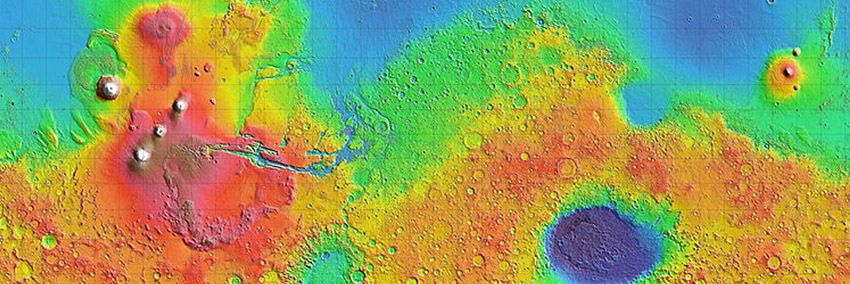Editor’s Note: Vectors and humans extensively terraformed Mars to make the environment hospitable. Later, Venus was radically transformed by Vectors, who replaced its atmosphere and even changed its rotation. overall, it’s quite similar to Terra, though with harsher winds and more extreme geography. (6)
For clarity, “years” and “days” refer to the martian cycle unless otherwise stated.
Mars’s year is longer, and more complex, than its inner cousins. A Martian year is equal to 1.88 years terran, 669 days long. It has four seasons – Winter, Spring, Summer, Fall–but because Mars has a more eccentric and somewhat egg-shaped orbit than Terra, its seasons vary in length:
Spring (Northern Hemisphere)/Fall (Southern Hemisphere: 194 days
Summer (North)/Winter (South): 178 days
Fall (North)/Spring (South): 142 days
Winter (North)/Summer (South): 154 days Nasa Mars Mobile: Martian Year (1)
To add to this eccentric spread of days, Mars’s lopsided orbit brings the planet closest to the sun in the Northern winter, furthest in the Northern summer. Seasons were more extreme before Mars’s terraforming, but the planet still receives 40% more energy from the sun at perihelion. In the north, winters are short and relatively warm, summers are long and balmy. In the south, longer, colder winters and shorter, hot summers.
Before Terraforming
Before terraforming, Mars was known to have massive dust storms on an annual basis–usually in perihelion (Southern summer.) These dust storms would cover a continent-sized area, but weren’t fast by earth standards – 60 miles an hour, tops. But the dust on Mars is fuzzy and pick up static, like foam packing peanuts, and gets everywhere, a damnable nuisance to electronic devices. For reasons that are as yet unknown, Mars has truly massive dust storms every three years or so, covering the entire planet. The dust reflects sunlight and makes the air cooler.
Another annual visitor is the northern annular cloud: A cloud some 1,600 km wide near the northern pole. It’s a cloud of water ice, white instead of dust-colored, and looks much like a hurricane, complete with an eye –though it doesn’t spin. The cloud turns up in the balmy Northern summer, when water has evaporated from the polar ice cap.
In pre-terraforming Mars, three variables make up the annual cycle–dust patterns, atmospheric and frozen carbon dioxide, and water vapor. The way these three forces work together, trapping and reflecting heat, likely creates the strange three-year cycle of the global dust storms. (4)
“Today:” What Does it Mean for Vectors?
In the year 2700, Mars has long since been converted into a Terra-like planet, not only habitable but sustaining much of the wildlife from Earth. We can assume that Mars’s climate is quite earthlike. There’s some hints that it’s not as idyllic as Terra was though–for instance, the interest in Terra as the jewel of the Goldilocks zone (5), and it’s substantially smaller (about 30% the surface area of Earth, though there may be proportionally more dry land, since water had to be created as a part of terraforming.) Winds are harsher on Mars as well. Overall, you could imagine Mars as being on average a bit cooler than earth, with more extreme winters and summers driven by perihelion. (6)
More extreme temperatures, altitudes, winds, a deep winter and a peak summer for the Southern hemisphere. It may be paradise, but Mars may occasionally remind the Vector race that it hasn’t always been tame. For plot purposes, it may be useful to remember that three-year cycle, and let the old Mars surface every few years–perhaps a longer period, 10 or 20 years–and after a year of summer drought and bitter winter, let the wind kick up a new global dust bowl. It’s only for a month, then the rains come again with the chilling of the air, replacing dust with mud. Small price to pay for a custom home world, but a useful plot point if Mars seems too placid.
Location-wise, the Valles Marineris is the place to be, the 3,000 mile valley along the planet’s equator where the rich and famous congregate–the social capital of Mars, with a distinctly old world political style (generations of social warfare seem more like “Game of Thrones” culturally.) The Valles Marineris is the oldest money, but the new money may have dcrifted to the northern hemisphere. With its strangely optimal climate, the coasts near the Utopia Planitia (7) may take on a culture like California’s Silicon Valley–nearly perfect weather and a broad, shallow ocean, beauty only marred by the high cost of living. In the winter, San Francisco might become Seattle as the Annular Cloud darkens the sky for a month, but that’s a small price to pay to live in the solar system’s best zip code. Perhaps the only small price to pay!
Sources:
(1) Nasa Mars Mobile: Martian Year
(2) astro.indiana.edu: Planet Temperature Calculator
(3) Nasa: The Fact and Fiction of Martian Dust Storms
(4) Mars Climate Modeling Group: Climate Cycles
(5) Hc Svnt Dracones 1.0, p.21
(6) Hc Svnt Dracones 1.0, p. 61)
(7) Wikipedia, “Vastitas Borealis“

